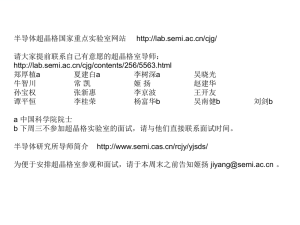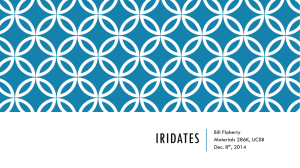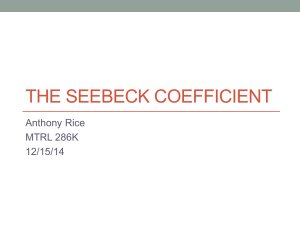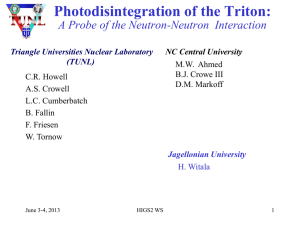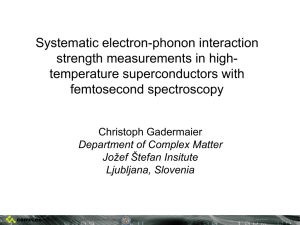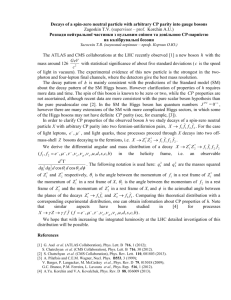project description - Center for Ultracold Atoms
advertisement
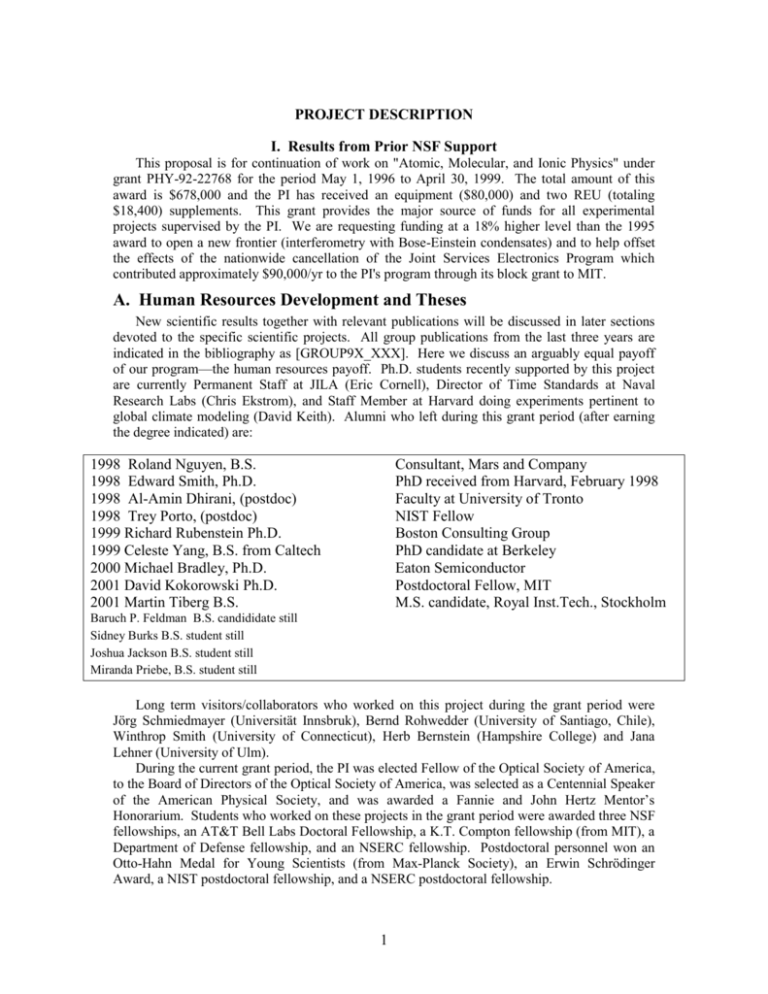
PROJECT DESCRIPTION I. Results from Prior NSF Support This proposal is for continuation of work on "Atomic, Molecular, and Ionic Physics" under grant PHY-92-22768 for the period May 1, 1996 to April 30, 1999. The total amount of this award is $678,000 and the PI has received an equipment ($80,000) and two REU (totaling $18,400) supplements. This grant provides the major source of funds for all experimental projects supervised by the PI. We are requesting funding at a 18% higher level than the 1995 award to open a new frontier (interferometry with Bose-Einstein condensates) and to help offset the effects of the nationwide cancellation of the Joint Services Electronics Program which contributed approximately $90,000/yr to the PI's program through its block grant to MIT. A. Human Resources Development and Theses New scientific results together with relevant publications will be discussed in later sections devoted to the specific scientific projects. All group publications from the last three years are indicated in the bibliography as [GROUP9X_XXX]. Here we discuss an arguably equal payoff of our program—the human resources payoff. Ph.D. students recently supported by this project are currently Permanent Staff at JILA (Eric Cornell), Director of Time Standards at Naval Research Labs (Chris Ekstrom), and Staff Member at Harvard doing experiments pertinent to global climate modeling (David Keith). Alumni who left during this grant period (after earning the degree indicated) are: 1998 Roland Nguyen, B.S. 1998 Edward Smith, Ph.D. 1998 Al-Amin Dhirani, (postdoc) 1998 Trey Porto, (postdoc) 1999 Richard Rubenstein Ph.D. 1999 Celeste Yang, B.S. from Caltech 2000 Michael Bradley, Ph.D. 2001 David Kokorowski Ph.D. 2001 Martin Tiberg B.S. Consultant, Mars and Company PhD received from Harvard, February 1998 Faculty at University of Tronto NIST Fellow Boston Consulting Group PhD candidate at Berkeley Eaton Semiconductor Postdoctoral Fellow, MIT M.S. candidate, Royal Inst.Tech., Stockholm Baruch P. Feldman B.S. candididate still Sidney Burks B.S. student still Joshua Jackson B.S. student still Miranda Priebe, B.S. student still Long term visitors/collaborators who worked on this project during the grant period were Jörg Schmiedmayer (Universität Innsbruk), Bernd Rohwedder (University of Santiago, Chile), Winthrop Smith (University of Connecticut), Herb Bernstein (Hampshire College) and Jana Lehner (University of Ulm). During the current grant period, the PI was elected Fellow of the Optical Society of America, to the Board of Directors of the Optical Society of America, was selected as a Centennial Speaker of the American Physical Society, and was awarded a Fannie and John Hertz Mentor’s Honorarium. Students who worked on these projects in the grant period were awarded three NSF fellowships, an AT&T Bell Labs Doctoral Fellowship, a K.T. Compton fellowship (from MIT), a Department of Defense fellowship, and an NSERC fellowship. Postdoctoral personnel won an Otto-Hahn Medal for Young Scientists (from Max-Planck Society), an Erwin Schrödinger Award, a NIST postdoctoral fellowship, and a NSERC postdoctoral fellowship. 1 B. Impact Counting only national and international scientific meetings, the PI has been invited to present about 30 invited talks on our NSF-supported work during the last three years, resulting in many conference proceedings [GROUP96_PCHb, GROUP96_SCH, GROUP97_KHS, GROUP98_KDH, GROUP98_PCH, GROUP98_RBP]. Some of these talks were given by other group members and some were declined, so the PI does spend considerable time at MIT supervising the project. In addition to a lengthy review of our interferometer experiments [GROUP97_SCE], we have reviewed certain aspects of our work and atomic physics in general for wider audiences [GROUP95_GOP, GROUP96_CHP, GROUP96_PCHa, GROUP96_PHL, GROUP97_PAP, GROUP97_PCE, GROUP98_WWP]. The broad appreciation of atomic physics generated in part by our research is further evidenced by the many third-party write-ups in both popular and general professional magazines, including Science [SEI97], Nature [SUD96], Discover [POO97], the American Physical Society’s Physics News in 1997 [SCS97], Scientific American [YAM97], and others [HEC96, WAT96]. 2 PROJECT DESCRIPTION: ATOM INTERFEROMETER A. Introduction Atom interferometers, in which atom or molecule de Broglie waves are coherently split and then recombined to produce interference fringes, have now become precision instruments. The ability to accurately measure interactions that displace the de Broglie wave phase has led to qualitatively new measurements in three broad areas: atomic and molecular physics [REF], fundamental tests of quantum mechanics [REF], and new ways to measure acceleration [REF] and rotation[REF]. Our group has pioneered techniques in each of these areas, including the first (and only) atom interferometry experiments that employ physically separated paths. In the last three years we have been applying these techniques to make new types of measurements. These investigations are ready to move beyond demonstrations -- which have already captivated widespread general interest -- toward dedicated precision measurement applications. Figure 1. A schematic of our atom interferometer. The 0 th and 1st diffracted orders from the first grating are redirected by the middle grating and form an interference pattern in the plane of the third grating. The detector records the flux transmitted through the third grating. A 10µm thick silicon septum before the 2nd grating separates the two arms of the interferometer. All critical components are mounted on a vibrationally isolated breadboard including the gratings, an optical interferometer (thick lines) to measure the relative positions of the atom gratings, and inertial sensors to monitor the overall board translation/rotation. B. Recent Scientific Results and Publications: Decoherence from Multiple Photon Scattering Using our improved Mach Zehnder interferometer for atoms we completed a study of quantum decoherence in the photon bath regeim. The process of decoherence in quantum systems has been described as the collapse of the wave function, and causes a transition from from quantum mechanical to classical behavior. We have studied this emergence of classical behavior by scattering a controlled number of photons from each atom within the interferometer. We have demonstrated a calculable and universal form of decoherence which is relevant to quantum computation, quantum error correction, and quantum communication [KCR01]. Figure 2. Demonstration of the change in character of spatial decoherence with number of photon scattering events. The interfering contrast is plotted as a function of the separation between the two interfering paths at the point of scattering. Each curve corresponds to a different mean and standard deviation of the number of scattering events (indicated). Contrast revivals in the small photonnumber limit are clearly washed out as more scattering events occur. In the large photon-number limit, the contrast loss relaxes towards a gaussian. 3 Dispersion in the Matter Wave Index of Refraction We are now measuring the velocity dependence of the index of refraction seen by sodium matter-waves passing through a gas target. In optical parlance, we measure the dispersion, i.e. the variation of index with wavelength. Our experiment's unique sensitivity to the phase shift of forward-scattered atoms provides data which have never before been available for studying atomatom interactions. In addition, our recent experiment shows strong evidence for glory oscillations in the phase shift - a novel interference effect which manifests as oscillations in the index of refraction as a function of impact velocity [ADV95]. Much theoretical work has been stimulated by our earlier measurements of the matter-wave index of refraction [SCE95], and there are conflicting predictions on how the index should vary with velocity [ADV95, CAD97, FLK96, FLK97, VIG95]. The variance in the predictions arises because the index is sensitive to both long-range (>5 Angstrom) and medium-range (0.5 to 5 Angstrom) inter-atomic potentials. We are collaborating with theorist Robert Forrey in using our recent measurements to refine the shapes of the long-range potentials between sodium and other gases (Ar, N2, Kr, and Xe) and to test the new theoretical predictions inspired by our earlier work. Figure 3. Preliminary data on the Re/Im ratio of the index of refraction for Na matter waves passing through Ar, N2, Kr, and Xe. The data are plotted as a function of the velocity of the incident Na atoms. The solid lines are the result of calculations using potentials found in the litterature [ADV95, BKZ91, CAD97, BZB92]. Electronic phase chopping The velocity distribution of our atom beam limits the accuracy of several different interferometer experiments. Most interactions we seek to study, such as the Stark shift, gravity, or rotations, cause a phase shift that depends on interaction time, i.e. is proportional to 1/velocity. A spread in velocity therefore causes a spread in phase-shift of the interference pattern, which lowers the atom-interference contrast if the average applied phase is large. Velocity multiplexing [HPC95] has been proposed to overcome this de-phasing without loosing the count rate as would happen with simple velocity selection. We have implemented our novel velocity-multiplexing scheme [HPC95, TIB01]. Rather than using choppers we employ two separated regions of inhomogeneous electric fields that can be pulsed on and off in time. Velocity multiplexing overcomes the limitations of having uncertainties and variation in the atoms’ velocity distribution, and will allow us to make much more precise measurements of atomic poliarzabilities. 4 A. B. Figure 4A. The inhomogeneous electric field regions used to implement velocity multiplexing. The timevarying electric field gradients imprint a velocity-dependant phase on the atoms in the interferometer of either 0 or radians. This will enable us to study larger perturbations to the interferometer. .Figure 4B. The revivals in contrast depend on the frequency at which the electric field regions are pulsed. These data, taken in the absence of an applied potential, indicate the velocity multiplexing is working properly. C. Interferometry Techniques and Groundwork Atom Gratings Our group has pioneered the development of transverse atom interferometry with microfabricated transmission diffraction gratings, employing a three grating Mach-Zehnder geometry [REF]. Collaborating with T. Savas in H. Smith’s group at MIT to fabricate improved gratings using Achromatic Interferometric (optical) Lithography, we have demonstrated atom interference fringes using 100-nm period gratings. These give twice the beam separation of our standard 200nm gratings. These gratings will make separated beam interferometry feasible with cesium atoms, and have expanded the velocity range we can use. The excellent large-scale uniformity of these gratings will also make it possible to use a hexapole magnet to focus our atom beam to increase the flux by a factor of 20. New Vacuum Chamber and Vibration Isolation With previous NSF support we upgraded our interferometer for longer paths, better phase stability, and more flexability to adapt experiments. The new vacuum chamber is ~3.5m long, which allows up to 200µm separation between the arms of our transverse interferometer. The atom optical components are now mounted on a vibrationally isolated breadboard to reduce phase drift (crucial for future precision measurements), and to suppress vibrational noise to less than 10nm rms (necessary to achieve high contrast interference with 100nm period gratings.) Furthermore, the apparatus now has a large number of access ports for flexibility in designing experiments. Thin Septum Using precision fabrication tools available at the MIT Microsystems Technologies Laboratory, we have developed new techniques for manufacturing narrow freestanding membranes, or septa, which we use to physically isolate the atom waves traversing the two arms of our interferometer. We now construct a septum by anodically bonding a thin (10µm), rigid silicon wafer to a borosilicate glass substrate in which a cavity has been cut to permit passage of the atom beam and to serve as a gas cell for the index of refraction experiments described above. Vacuum deposition of a metal film will create a conducting surface to be used in proposed polarizability measurements and studies of relativistic effects. 5 D. Proposed Experiments With our improved interferometer, we plan to emphasize new and more precise measurements in atomic physics as well as fundamental experiments in quantum mechanics. Our first priority, is to measure the polarizability of cesium. The extreme sensitivity of our device will also allow us to investigate novel relativistic and topological phases that have engendered recent theoretical controversy. Polarizability of Multiple Alkalis An atom’s polarizability governs its interaction with electric fields and is an important parameter in Van der Waals interactions, electric dipole transition rates, and long-range interatomic potentials. Several theoretical groups have expressed their interest in polarizability measurements including Prof. Walter Johnson who calculated the polarizability of sodium to compare with our earlier measurement [GROUP95_SCE] as part of his program to check the atomic structure theories needed to interpret measurement of atomic parity violation in cesium [NMW88, WBC97]. We propose to measure the polarizabilities of the alkali metals from Na to Cs to <0.1% accuracy—more than an order of magnitude better than current values (except for sodium [GROUP95_ESC]), and to measure their relative polarizability at the 0.01% level. The species independence of our gratings (unlike light gratings) allows us to switch alkalis easily, and velocity multiplexing will increase our accuracy and precision to the 0.1% and 0.01% targets. We have already demonstrated most of the technologies required for measuring polarizabilities with increased precision. The successes we shall build upon include: low-phase drift in our apparatus because of the isolated breadboard, an ultra-thin 10m septum, the 100-nm atom gratings which are required for separating beams with short de Broglie wavelengths, and the electronic method of velocity multiplexing. Anisotropic Polarizability of Sodium Molecules We propose to make the first measurement of both the parallel and the perpendicular components of the polarizability of the dimer molecule Na2 using our techniques of molecular [GROUP95_CEH] and contrast [GROUP94_SEC] interferometry. This will permit tests of various approximations used in molecular structure calculations [BOK94, MIB88]. The asymmetry of the polarizability causes the phase shift to depend on the molecule’s orientation so that the contrast decreases more rapidly with electric filed if the asymmetry is higher. Relativistic Effects An atom’s extreme sensitivity to electric and magnetic fields is sufficient that the relativistically small fields generated by its motion can produce observable phase shifts. These relativistic fields add velocity dependent terms to the atomic Hamiltonian, resulting in a difference between the canonical and kinematic momenta. Questions remain about how to incorporate such relativistic terms into the standard non-relativistic formulation of quantum mechanics [WAR97]. These phase shifts are also intriguing by virtue of their linear velocity dependence, which cancels the usual 1 v dispersion of phase shifts in an interferometer, resulting in a velocity independent and sometimes purely topological phase. Induced Dipole in a Magnetic Field It has recently been predicted [WEH95, WIL94] that a neutral, polarizable particle which moves in crossed electric and magnetic fields acquires a non-trivial quantum phase resulting from 6 the interaction between the induced electric dipole moment and the motion-induced electric field. Another author contends that the predicted effect is unobservable [HAG96]. This effect represents the next logical extension of investigations into various topological phases sparked by the remarkable discovery of the Berry phase and its simplest examples, the Aharanov-Bohm and Aharanov-Casher effects. One proposal calls for a separated beam of neutral atoms to pass on either side of a charged foil immersed in a magnetic field so that the cross product ExB has opposite sign on the two sides—an arrangement easily achieved using our thin septum technology. We propose to look for the predicted induced dipole phase shift of ~0.01rad, easily within the milliradian resolution of our interferometer. REFERENCES CITED [ADV95] [ANA89a] [ANA89b] [ANH94] [APZ97] [ASH90] [ATM97] [AUW93] [BCD94] [BEC95] [BEL87] [BEL95] E. Audouard, P. Duplaa and J. Vigue, "Glory and Resonance Effects in the Index of Refraction for Atomic Waves" Europhys. Lett. 32, 397-400 (1995). J. Anandan, "Electromagnetic Effects in the Quantum Interference of Dipoles" Phys. Lett. A 138, 347 (1989). J. Anandan, "Interaction of a Dipole with the Electromagnetic Field: Quantum Interference, Classical Limit and Field Equations" in Proceedings of 3rd Int. Symp. Foundations of Quantum Mechanics, Tokyo, 1989. J. Anandan and C.R. Hagen, "Neutron Acceleration in Uniform Electromagnetic Fields" Phys. Rev. A 50, 2860-2864 (1994). J.R. Anglin, J.P. Paz and W.H. Zurek, "Deconstructing Decoherence" Phys. Rev. A 55, 4041-4053 (1997). E.G. Adelberger, C.W. Stubbs, B.R. Heckel, Y. Su, H.E. Swanson, G. Smith, J.H. Gundlach and W.F. Rogers, "Testing the equivalence principle in the field of the Earth: Particle physics at masses below 1 microeV?" Phys. Rev. D 42, 3267 (1990). M.R. Andrews, C.G. Townsend, H.J. Miesner, D.S. Durfee, D.M. Kurn and W. Ketterle, "Observation of Interference Between Two Bose Condensates" Science 275, 637-641 (1997). G. Audi and A.G.Wapstra, "The 1993 atomic mass evaluation" Nuc.Phys. A 565, 1 (1993). C.J. Bordé, N. Courtier, F. duBurck, A.N. Goncharov and M. Gorlicki, "Molecular Interferometry Experiments" Phys. Lett. A 188, 187 (1994). P. Backer, H. Bettin, P.D. Bievre, C. Holm, U. Kutgens, F. Spieweck, J. Stumpel, S. Valkiers and W.Zulehner, "The 28Si path to the Avogadro constant: First experiments and outlook" IEEE Trans. Inst. Meth. 44, 522 (1995). H.J. Bernstein and F.E. Low, "Measurement of Longitudinal Coherence Lengths in Particle Beams" Phys. Rev. Lett. 59, 951-953 (1987). A.I. Belesev, "Results of the Troitsk experiment on the search for the electron antineutrino rest mass in tritium beta-decay" Phys. Lett. B 350, 263 (1995). 7 [BIE95] [BOK94] [CAD97] [CAM91] [CAS94] [CAW92] [CDE89] [CKS97] [CKS97] [CLD96] [CLL94] [COM83] [COT87] [CWM93] [FLK96] [FLK97] [FSW98] [FVS95] P.D. Bievre, S. Valkiers, S. Peiser, P. Becker, F. Ludicke, F. Spieweck and J. Stumpel, "A more accurate value for the Avogadro constant" IEEE Trans. Inst. Meth. 44, 530 (1995). K.D. Bonin and M.A. Kadarkallen, "Linear Electric-Dipole Polarizabilities" Int. J. Mod. Phys. B 8, 3313-3370 (1994). C. Champenois, E. Audouard, P. Duplaa and J. Vigué, "Refractive Index for Atomic Waves: Theory and Detailed Calculations" J. de Phys II 7, 523 (1997). O. Carnal and J. Mlynek, "Young's double slit experiment with atoms: A simple atom interferometer" Phys. Rev. Lett. 66, 2689 (1991). R.C. Casella, "Poles of Local Classical Acceleration and Spatial Separation in the Neutral Particle Analogs of the Aharonov-Bohm Phases" Phys. Rev. Lett. 73, 2941-2945 (1994). R.C. Casella and S.A. Werner, "Electromagnetic Acceleration of Neutrons" Phys. Rev. Lett. 69, 1625-1628 (1992). M.E. Cage, R.F. Dziuba, R.E. Elmquist, B.F. Field, G.R.J. Jr, P.T. Olsen, W.D. Phillips, J.Q. Shields, R.L. Steiner, B.N. Taylor and E.R. Williams, "NBS determination of the fine-structure constant, and of the quantized Hall resistance and Josephson frequency-to-voltage quotient in SI units" IEEE Trans. Inst. Meas. 38, 284 (1989). S.B. Cahn, A. Kumarakrishnan, U. Shim, T. Sleator, P.R. Berman and B. Dubetsky, "Time-domain de Broglie Wave Interferometry" Phys. Rev. Lett. 79, 784-787 (1997). S.B. Cahn, A. Kumarakrishan, U. Shim, T. Sleator, P.R. Berman and B. Dubetsky, "Time-domain de Broglie wave interferometry" Phys. Rev. Lett. 79, 784-787 (1997). J.F. Clauser and J.P. Dowling, "Factoring Integers with Young's N-slit Interferometer" Phys. Rev. A 53, 4587-4590 (1996). J.F. Clauser and S.F. Li, "Talbot-vonLau Atom Interferometry with Cold Slow Potassium" Phys. Rev. A 49, R2213-R2216 (1994). G. Comsa, "Comment on "Direct Measurement of the Longitudinal Coherence Length of a Thermal Neutron Beam"" Phys. Rev. Lett. 51, 1105 (1983). E.R. Cohen and B.N. Taylor, "The 1986 Adjustment of the Fundamental Physical Constants" Rev. Mod. Phys. 57, 1121 (1987). S.N. Chormaic, V. Wiedemann, C. Miniatura, J. Robert, S. Leboiteux, V. Lorent, O. Gorceix, S. Feron, J. Reinhardt and J. Baudon, "Longitudinal Stern-Gerlach Atomic Interferometry using Velocity Selected Atomic-beams" J. Phys. B 26, 1271-1279 (1993). R.C. Forrey, Y. Li, V. Kharchenko and A. Dalgarno, "Index of Refraction of Noble Gases for Sodium Matter Waves" Phys Rev A 54, 2180 (1996). R.C. Forrey, Y. Li, V. Kharchenko and A. Dalgarno, "Refining Molecular Potentials using Atom Interferometry" Phys. Rev. A 55, R3311-R3314 (1997). P.D. Featonby, G.S. Summy, C.L. Webb, R.M. Godun, M.K. Oberthaler, A.C. Wilson, C.J. Foot and K. Burnett, "Separated-path Ramsey atom interferometer" Phys. Rev. Lett. 81, 495-499 (1998). D.L. Farnham, J. R.S. Van Dyck and P.B. Schwinberg, "Determination of the electrons atomic mass and the proton/electron mass-ratio via Penning trap mass spectrometry" Phys. Rev. Lett. 3598 (1995). 8 [GAG84] [GAT88] [GBK97] [GDK91] [GML95] [GROUP88_WLB] [GROUP90_CWB] [GROUP92_CBF] [GROUP93_NBD] [GROUP94_DNB] [GROUP94_DNB] [GROUP94_SEC] [GROUP95_CEH] [GROUP95_CHL] [GROUP95_DNB] [GROUP95_ESC] [GROUP95_GOP] R. Gähler and R. Golub, "Time Dependant Neutron Optics—Quantum Mechanical Effects on Beam Chopping and a New Type of High Resolution Neutron Spectrometer" Z. Phys. B 56, 5-12 (1984). G. Gabrielse and J. Tan, "Self-shielding superconducting solenoid systems" J. Appl. Phy. 63, 5143 (1988). T.L. Gustavson, P. Bouyer and M.A. Kasevich, "Precision Rotation Measurements with an Atom Interferometer Gyroscope" Phys. Rev. Lett. 78, 2046-2049 (1997). G.L. Greene, M.S. Dewey, J. E.G. Kessler and E. Fischbach, "Test of special relativity by a determination of the Lorentz limiting velocity: does E=mc/sup 2/?" Phys. Rev. D (Part., Fields) 44, R2216 (1991). D.M. Giltner, R.W. McGowan and S.A. Lee, "Atom Interferometer Based on Bragg Scattering from Standing Light Waves" Phys. Rev. Lett. 75, 26382641 (1995). R.M. Weisskoff, G.P. Lafyatis, K.R. Boyce, E.A. Cornell, R.W.F. Jr. and D.E. Pritchard, "RF SQUID detector for single-ion trapping experiments" J. Appl. Phys 63, 1674 (1988). E.A. Cornell, R.M. Weisskoff, K.R. Boyce and D.E. Pritchard, "Mode coupling in a Penning trap: pi pulses and a classical avoided crossing" Phys. Rev. A 41, 312 (1990). E.A. Cornell, K. Boyce, D.L.K. Fygenson and D.E. Pritchard, "Two ions in a Penning trap: Implications for precision mass spectroscopy" Phys Rev A 45, 3049 (1992). V. Natarajan, K.R. Boyce, F. DiFilippo and D.E. Pritchard, "Precision Penning trap comparison of nondoublets: atomic masses of H, D, and the neutron" Phys. Rev. Lett. 71, 1998 (1993). F. DiFilippo, V. Natarajan, K. Boyce and D.E. Pritchard, "Accurate masses for fundamental metrology" Phys. Rev. Lett. 73, 1481 (1994). F. DiFilippo, V. Natarajan, K. Boyce and D.E. Pritchard, "Classical amplitude squeezing for precision measurements" Phys. Rev. Lett. 68, 2859 (1992). J. Schmiedmayer, C.R. Ekstrom, M.S. Chapman, T.D. Hammond and D.E. Pritchard, "Magnetic Coherences in Atom Interferometry" J. de Phys. II 4, 2029 (1994). M.S. Chapman, C.R. Ekstrom, T.D. Hammond, R.A. Rubenstein, J. Schmiedmayer, S. Wehinger and D.E. Pritchard, "Optics and Interferometry with Na2 Molecules" Phys. Rev. Lett. 74, 4783-4786 (1995). M.S. Chapman, T.D. Hammond, A. Lenef, J. Schmiedmayer, R.R. Rubenstein, E. Smith and D.E. Pritchard, "Photon Scattering from Atoms in an Atom Interferometer: Coherence Lost and Regained" Phys. Rev. Lett 75, 3783 (1995). F. DiFilippo, V. Natarajan, M. Bradley, F. Palmer and D.E. Pritchard, "Accurate atomic mass measurements from Penning trap mass comparisons of individual ions" Physica Scripta T59, 144-154 (1995). C.R. Ekstrom, J. Schmiedmayer, M.S. Chapman, T.D. Hammond and D.E. Pritchard, "Measurement of the Electric Polarizability of Sodium with an Atom Interferometer" Phys. Rev. A 51, 3883 (1995). P.L. Gould and D.E. Pritchard, "Atoms Interacting with Standing Light Waves: Diffraction, Diffusion and Rectification" in Proceedings of Enrico Fermi Summer School on "Coherence and Collective Interactions of Particles and Radiation Beams", Varenna, Italy, 1995. 9 [GROUP95_HPC] T.D. Hammond, D.E. Pritchard, M.S. Chapman, A.Lenef and J.Schmiedmayer, "Multiplex Velocity Selection for Precision Matter-wave Interferometry" Appl. Phys. B 60, 193 (1995). [GROUP95_NDP] V. Natarajan, F. DiFilippo and D.E. Pritchard, "Classical squeezing of an oscillator for subthermal noise operation" Phys. Rev. Lett. 74, 2855 (1995). [GROUP95_RTCa] M.J. Rooks, R.C. Tiberio, M.S. Chapman, T.D. Hammond, E.T. Smith, A. Lenef, R.A. Rubenstein, D.E. Pritchard, S. Adams, J. Ferrera, J.M. Carter and H.I. Smith, "Coherence and Structural Design of Free-Standing Gratings for Atom-Wave Optics" Jpn. J. Appl. Phys. 34, 6935-6939 (1995). [GROUP95_RTCb] M.J. Rooks, R.C. Tiberio, M.S. Chapman, T.D. Hammond, E.T. Smith, A. Lenef, R.A. Rubenstein, D.E. Pritchard and S. Adams, "Coherence of Large Gratings and Electron-beam Fabrication Techniques for Atom-wave Interferometry" J. Vac. Sci. Technol. B 13, 2745 (1995). [GROUP95_RUS] S. Rusinkiewicz. Ph.D. Thesis, Massachusetts Institute of Technology, 1995. [GROUP95_SCE] J. Schmiedmayer, M.S. Chapman, C.R. Ekstrom, T.D. Hammond, S. Wehinger and D.E. Pritchard, "Index of Refraction of Various Gases for Sodium Matter-waves" Phys. Rev. Lett. 74, 1043 (1995). [GROUP96_CHP] M.S. Chapman and D.E. Pritchard, "Taking the Gedanken out of a Feynman Gedankenexperiment" IEEE/LEOS Newsletter 10, (1996). [GROUP96_PCHa] D.E. Pritchard, M.S. Chapman, T.D. Hammond, D.A. Kokorowski, A. Lenef, R.A. Rubenstein, E.T. Smith and J. Schmiedmayer, "Quantum Decoherence and Inertial Sensing with Atom Interferometers" in Proceedings of 15th International Conference on Atomic Physics, Amsterdam, The Netherlands, 1996. [GROUP96_PCHb] D.E. Pritchard, M.S. Chapman, T.D. Hammond, A. Lenef, R.A. Rubenstein, E.T. Smith and J. Schmiedmayer, "Quantum Interferometry" in Proceedings of Adriatico Workshop, International Centre for Theoretical Physics, Trieste, Italy, 1996. [GROUP96_PHL] D.E. Pritchard, T.D. Hammond, A. Lenef, J. Schmiedmayer, R.A. Rubenstein, E.T. Smith and M.S. Chapman, "Using an atom interferometer to take the Gedanken out of Feynman's gedankenexperiment" in Proceedings of Conference on Resonance Ionization Spectroscopy, State College, PA, USA, 1996. [GROUP96_SCH] J. Schmiedmayer, M.S. Chapman, T.D. Hammond, A. Lenef, R.A. Rubenstein, E.T. Smith and D.E. Pritchard, "Photon Scattering and Atomic Interference" Laser Physics 6, 284-289 (1996). [GROUP97_DKR] A. Dhirani, D.A. Kokorowski, R.A. Rubenstein, T.D. Hammond, B. Rohwedder, E.T. Smith and D.E. Pritchard, "Determining the Density Matrix of a Molecular Beam Using a Longitudinal Matter Wave Interferometer" J. Mod. Opt. 44, 2583-2589 (1997). [GROUP97_HCL] T.D. Hammond, M.S. Chapman, A. Lenef, J. Schmiedmayer, E.T. Smith, R.A. Rubenstein, D.A. Kokorowski and D.E. Pritchard, "Matter-Wave Index of Refraction, Inertial Sensing, and Quantum Decoherence in an Atom Interferometer" Braz. J. Phys. 27, 193-213 (1997). [GROUP97_KHS] D.A. Kokorowski, A. Dhirani, T.D. Hammond, B. Rohwedder, R.A. Rubenstein, E.T. Smith and D.E. Pritchard, "Atomic beam propagation effects: index of refraction and longitudinal tomography" in Proceedings of SPIE Conference on Atom Optics, San Jose, CA, USA, 1997. [GROUP97_KOP] D.A. Kokorowski and D.E. Pritchard, "Longitudinal Quantum Beam Tomography" J. Mod. Opt. 44, 2575-2581 (1997). 10 [GROUP97_LHS] A. Lenef, T.D. Hammond, E.T. Smith, M.S. Chapman, R.A. Rubenstein and D.E. Pritchard, "Rotation Sensing with an Atom Interferometer" Phys. Rev. Lett. 78, (1997). [GROUP97_PAP] F. Palmer and D.E. Pritchard. in Yearbook of Science and Technology , p. 291-293, edited by (McGraw-Hill, 1997). [GROUP97_PCE] D.E. Pritchard, M.S. Chapman, C.R. Ekstrom, T.D. Hammond, D.A. Kokorowski, A. Lenef, R.A. Rubenstein, J. Schmiedmayer and E.T. Smith, "Interferometry with atoms and molecules: a tutorial" in Proceedings of SPIE Conference on Atom Optics, San Jose, CA, USA, 1997. [GROUP97_SCE] AAMOP book J. Schmiedmayer, M.S. Chapman, C.R. Ekstrom, T.D. Hammond, D.A. Kokorowski, A. Lenef, R.A. Rubenstein, E.T. Smith and D.E. Pritchard. in Atom Interferometry , Advances in Atomic and Molecular Physics, p. 2-83, edited by P.R. Berman (Academic Press, San Diego, 1997). [GROUP98_KDH] D.A. Kokorowski, A. Dhirani, T.D. Hammond, B. Rohwedder, R.A. Rubenstein, E.T. Smith and D.E. Pritchard, "Fully Quantized Treatment of Molecular Beam Resonance" Fortschr. Phys. 46, ##-## (1998). [GROUP98_PCH] D.E. Pritchard, M.S. Chapman, T.D. Hammond, D.A. Kokorowski, A. Lenef, R.A. Rubenstein, E.T. Smith and J. Schmiedmayer, "Atom Interferometers and Atomic Coherence" Fortschr. Phys. 46, ##-## (1998). [GROUP98_PRD] D.E. Pritchard, R.A. Rubenstein, A. Dhirani, D.A. Kokorowski, E.T. Smith, T.D. Hammond and B. Rohwedder, "Longitudinal Atom Optics using Localized Oscillating Fields: A Fully Quantum Mechanical Treatment" Phys. Rev. A (Submitted) (1998). [GROUP98_RBP] S. Rainville, M.P. Bradley, J.V. Porto, J.K. Thompson and D.E. Pritchard, "Precision measurement of the mass of Cs: Toward a new value of the finestructure constant" in Proceedings of TCPFP 98, Monterey, CA, 1998. [GROUP98_SDK] E.T. Smith, A. Dhirani, D.A. Kokorowski, R.A. Rubenstein, T.D. Roberts, H. Yao and D.E. Pritchard, "Velocity Rephased Longitudinal Momentum Coherences with Differentially Detuned Separated Oscillatory Fields" Phys. Rev. Lett. 81, 1996-1999 (1998). [GROUP98_WWP] C.E. Wieman, D.J. Wineland and D.E. Pritchard, "Atom Cooling, Trapping and Quantum Manipulation" Rev. Mod. Phys. (Centennial Issue--to be published). [HAG96] C.R. Hagen, "Quantum Phase of Induced Dipoles Moving in a Magentic Field - Comment" Phys. Rev. Lett. 77, 1656 (1996). [HAW87] M.P. Haugan and C.M. Will, "Modern tests of special relativity" Phys. Today 40, 69 (1987). [HEA98] T.P. Heavner. Ph.D. Thesis, Univ. of Colorado, 1998. [HEC96] J. Hecht, "Atomic Interferometry, Physicists 'Find' Lost Coherence" Laser Focus World 32, 20 (1996). [HHF98] S. Hatakeyama et al., "Measurement of the flux and zenith-angle distribution of upward through-going muons in Kamiokande II+III" Phys. Rev. Lett. 81, 2016-2019 (1998). [HMW98] D.S. Hall, M.R. Matthews, C.E. Wieman and E.A. Cornell, "Measurements of relative phase in two-component Bose-Einstein condensates" Phys. Rev. Lett. 81, 1543-1546 (1998). [HPR97] H. Hinderthur, A. Pautz, V. Rieger, F. Ruschewitz, J.L. Peng, K. Sengstock and W. Ertmer, "Three-beam Atom Interferometer" Phys. Rev. A 56, 20852089 (1997). 11 [HPR98] [KAC91] [KAC92] [KAP97] [KED95] [KEP92] [KET91] [KIN95] [KNW95a] [KOH83] [KWG83a] [LIN89] [LJH86] [MBB97] [MBM97] [MIB88] [MLE97] [MOO95] [MSA98] [NMW88] [NPB95] H. Hinderthur, A. Pautz, F. Ruschewitz, K. Sengstock and W. Ertmer, "Atom interferometry with polarizing beam splitters" Phys. Rev. A 57, 4730-4735 (1998). M. Kasevich and S. Chu, "Atomic Interferometry using Stimulated Raman Transitions" Phys. Rev. Lett. 67, 181 (1991). M. Kasevich and S. Chu, "Measurement of the Gravitational Acceleration of an Atom with a Light-pulse Interferometer" Appl. Phys. B 54, 321 (1992). I.G. Kaplan, "Endpoint energy in the molecular b spectrum, atomic mass defect, and the negative m2/vcpuzzle" J. of Phys. G: Nucl. Part. Phys. 23, 683 (1997). E. Kessler and R. Deslattes, personal communication. W. Ketterle and D.E. Pritchard, "Trapping and focusing ground-state atoms with static Fields" App. Phys. B 54, 403-406 (1992). D.W. Keith, C.R. Ekstrom, Q.A. Turchette and D.E. Pritchard, "An Interferometer For Atoms" Phys. Rev. Lett. 66, 2693 (1991). T. Kinoshita, "New value of the alpha /sup 3/ electron anomalous magnetic moment" Phys. Rev. Lett. 75, 4728 (1995). E. Kruger, W. Nistler and W. Weirauch, "Determination of the fine-structure constant by a precise measurement of h/m/sub n/" Metrologia 32, 117 (1995). A.G. Klein, G.I. Opat and W.A. Hamilton, "Direct Measurement of the Longitudinal Coherence Length of a Thermal Neutron Beam" Phys. Rev. Lett. 50, 563-565 (1983). H. Kaiser, S.A. Werner and E.A. George, "Direct Measurement of the Longitudinal Coherence Length of a Thermal Neutron Beam" Phys. Rev. Lett. 50, 560-563 (1983). C. Lineberger, personal communication. S.K. Lamoreaux, J.P. Jacobs, B.R. Heckel, F.J. Raab and E.N. Fortson, "New limits on spatial anisotropy from optically pumped /sup201/Hg and /sup 199/Hg" Phys. Rev. Lett. 57, 3125 (1986). S.A. Morgan, R.J. Ballagh and K. Burnett, "Solitary-wave Solutions to NonLinear Schrödinger Equations" Phys. Rev. A 55, 4338 (1997). K.W. Madison, C.F. Bharucha, P.R. Morrow, S.R. Wilkinson, Q. Niu, B. Sundaram and M.G. Raizen, "Quantum Transport of Ultracold Atoms in an Accelerating Optical Potential" Appl. Phys. B 65, 693 (1997). T.M. Miller and B. Bederson, "Electric Dipole Polarizability Measurements" Adv. At. Mol. Phys. 25, 37 (1988). H. Monien, M. Linn and N. Elstner, "Is a Trapped One-Dimensional Bose gas a Luttinger Liquid?" preprint (1997). A. Morinaga and Y. Ohuchi, "Calcium-Atom Interferometer Comprised of 4 Copropagating Traveling Laser-Beams" Phys. Rev. A 51, R1746-R1449 (1995). H.-J. Miesner, D.M. Stamper-Kurn, M.R. Andrews, D.S. Durfee, S. Inouye and W. Ketterle, "Bosonic Stimulation in the Formation of a Bose-Einstein Condensate" Science 279, 1005 (1998). M.C. Noecker, B.P. Masterson and C.E. Wieman, "Precision Measurement of Parity Nonconservation in Atomic Cesium: A Low-Energy Test of the Electroweak Theory" Phys. Rev. Lett. 61, 310 (1988). F. Nez, M.D. Plimmer, S. Bourzeix, L. Julien, F. Biraben, R. Felder, Y. Millerioux and P.D. Natale, "Determination of the Rydberg constant by direct frequency measurement" IEEE Trans. Inst. Meas. 44, 568 (1995). 12 [OLS98] [PDB97] [PFK97] [PHI98] [POO97] [PRE98] [REC97] [ROB95] [RWK92] [SCD93] [SCS97] [SEI97] [SGA96] [SHI96] [SSH92] [SSH93] [SSM92] [STD95] [SUD96] [SUM97] [VFS93] [VFZ98] [VIG95] M. Olshanii, "Atomic Scattering in Presence of an External Confinement and a Gas of Impenetrable Bosons" preprint (1998). E. Peik, M.B. Dahan, I. Bouchoule, Y. Castin and C. Salomon, "Bloch Oscillations and an Accelerometer for Cold Atoms" Appl. Phys. B 65, 685 (1997). T. Pfau and C. Kurtsiefer, "Partial reconstruction of the motional Wigner function of an ensemble of helium atoms" J. Mod. Opt. 44, 2551-2564 (1997). W.D. Phillips, personal communication. R. Pool, "Beams of Stuff" Discover 103-107 (1997). M. Prentiss, personal communication. W.P. Reinhardt and C.W. Clark, "Soliton Dynamics in the Collisions of BoseEinstein Condensates: an Analogue of the Josephson Effect" J. de Phys. B 30, L785 (1997). E.M. Rasel, M.K. Oberthaler, H. Batelaan, J. Schmiedmayer and A. Zeilinger, "Atom Wave Interferometry with Diffraction Gratings of Light" Phys. Rev. Lett. 75, 2633-2637 (1995). F. Riehle, A. Witte, T. Kisters and J. Helmcke, "Interferometry with Ca Atoms" Appl. Phys. B 54, 333 (1992). M.O. Scully and J.P. Dowling, "Quantum-noise Limits to Matter-wave Interferometry" Phys. Rev. A 48, 3186-90 (1993). P.F. Schewe and B.P. Stein. Atom-Interferometer Gyroscopes 1-3 (1997). C. Seife, "Atoms Take a Turn for the Better" Science 275, 931 (1997). P. Szriftgiser, D. GueryOdelin, M. Arndt and J. Dalibard, "Atomic Wave Diffraction and Interference using Temporal Slits" Phys. Rev. Lett. 77, 4-7 (1996). F. Shimizu, "Interferometry with Laser Cooled Ne Atoms" Prog. Crys. Growth Char. Mat. 33, 395-400 (1996). V. Sandoghdar, C.I. Sukenik, E.A. Hinds and S. Haroche, "Direct Measurement of the Van der waals Interaction Atom and Its Images in a Micron-Sized Cavity" Phys. Rev. Lett. 3432-3435 (1992). K. Sengstock, U. Sterr, G. Hennig, D. Bettermann, J.H. Muller and W. Ertmer, "Optical Ramsey Interferences on Laser Cooled and Trapped Atoms, Detected by Electron Shelving" Opt. Comm. 103, 73-78 (1993). U. Sterr, K. Sengstock, J.H. Muller, D. Bettermann and W. Ertmer, "The Magnesium Ramsey Interferometer: Applications and Prospects" Appl. Phys. B 54, 341 (1992). W. Stoeffl and D.J. Decman, "Anomalous structure in the beta decay of gaseous molecular tritium" Phys. Rev. Lett. 75, 3237 (1995). T. Sudbery, "Illuminating Entanglement" Nature 379, 403-404 (1996). J. Summhammer, "Factoring and Fourier Transformation with a MachZehnder Interferometer" Phys. Rev. A 56, 4323-4326 (1997). R.S.V. Dyck, D.L. Farnham and P.B. Schwinberg, "Tritium-helium-3 mass difference using the Penning trap mass spectroscopy" Phys Rev. Lett. 70, 2888 (1993). R.S.V. Dyck, D.L. Farnham, S. Zafonte and P.B. Schwinberg, "High precision Penning trap mass spectroscopy and a new measurement of the proton's atomic mass" in Proceedings of ICAP 16, Windsor, Ontario, Canada, 1998. J. Vigué, "Index of Refraction of Dilute Matter in Atomic Interferometry" Phys. Rev. A 52, 3973 (1995). 13 [VNG98] R.N.V. Nguyen. Ph.D. Thesis, Massachussetts Institute of Technology, 1998. [WAR97] A. Wagh and V.C. Raknecha, "Electromagnetic Acceleration of Neutrons and its Observability" Phys. Rev. Lett. 78, 1399-1403 (1997). [WAT96] A. Watson, "Atoms Through the Looking Glass" New Scientist 150, 30-34 (1996). [WBC97] C.S. Wood, S.C. Bennett, D. Cho, B.P. Masterson, J.L. Roberts, C.E. Tanner and C.E. Wieman, "Measurement of Parity Nonconservation and an Anapole Moment in Cesium" Science 275, 1759-1763 (1997). [WEH95] H. Wei and R. Han, "Quantum Phase of Induced Dipoles Moving in a Magnetic Field" Phys. Rev. Lett. 75, 2071-2073 (1995). [WER94] S.A. Werner, "Gravitational, Rotational and Topological Quantum PhaseShifts in Neutron Interferometry" Classical and Quantum Gravity 11, A207A226 (1994). [WHH97] M. Weitz, T. Heupel and T.W. Hansch, "Multiple beam atom interferometer, theory and experiment" App. Phys. B. 65, 713-724 (1997). [WHS95] M. Weitz, A. Huber, F. Schmidt-Kaler, D. Leibfried, W.Vassen, C. Zimmermann, K. Pachucki, T.W. Hansch, L. Julien and F. Biraben, "Precision measurement of the 1S ground-state Lamb shift in atomic hydrogen and deuterium by frequency comparison" Phys. Rev. A 52, 2664 (1995). [WIL94] M. Wilkens, "Quantum Phase of a Moving Dipole" Phys. Rev. Lett. 72, 5-8 (1994). [WMM98] D.J. Wineland, C. Monroe, D.M. Meekhof, B.E. King, D. Leibfried, W.M. Itano, J.C. Bergquist, D. Berkeland, J.J. Bollinger and J. Miller, "Quantum State Manipulation of Trapped Atomic Ions" Proc. Roy. Soc. London A 454, 411-429 (1998). [WYC93] D.S. Weiss, B.C. Young and S. Chu, "Precision measurement of the photon recoil of Cs using atom interferometry" Phys. Rev. Lett. 70, 2706 (1993). [WYC94] D.S. Weiss, B.C. Young and S. Chu, "Precision measurement of h/m(Cs) based on photon recoil using laser-cooled atoms and atomic interferometry" App. Phys. B 59, 217-256 (1994). [YAM97] P. Yam, "Bringing Schrodinger's Cat to Life" Scientific American 276, 124129 (1997). [YOM98] S. Yanagimachi, Y. Omi and A. Morinaga, "Interference fringes of the atom interferometer comprised of four copropagating traveling laser beams" Phys. Rev. A 57, 3830-3836 (1998). [ZYC94] M. Weitz, B.C. Young and S. Chu, "Atomic interferometer based on adiabatic population transfer" Phys. Rev. Lett. 73, 2563 (1994). 14

